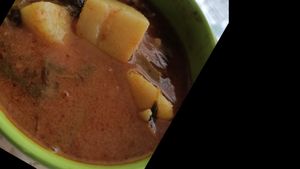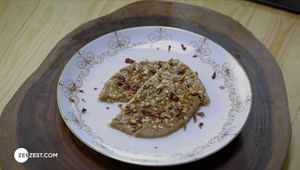Sindhi cuisine, rich in flavours and deeply rooted in tradition, boasts a variety of dishes that reflect the culture and heritage of the Sindhi community. Among these, one dish stands out for its simplicity, versatility, and deliciousness: koki. This flatbread, often compared to a paratha, is a staple in Sindhi households. In this blog, we'll explore the traditional koki recipe, delve into its variations like the koki paratha, and celebrate the authentic flavours of Sindhi cuisine.
What is Koki?

Koki is a traditional Sindhi flatbread made from whole wheat flour, onions, and spices. It is often enjoyed for breakfast but can be eaten at any time of the day. The preparation of koki is straightforward, making it a favourite among home cooks who want to whip up something quick yet nutritious and satisfying.
Traditional Sindhi Koki recipe
To make a classic koki, you need simple ingredients that are likely already in your pantry. Here's a traditional koki recipe for you to try:
Ingredients
- 2 cups whole wheat flour
- 1 large onion, finely chopped
- 2 green chillies, finely chopped
- 1 tablespoon chopped fresh coriander leaves
- 1 teaspoon cumin seeds
- 1 teaspoon carom seeds (ajwain)
- Salt to taste
- 2 tablespoons ghee or oil (for dough)
- Ghee or oil for cooking
Process of making Sindhi Koki
Prepare the dough
- In a large bowl, combine the whole wheat flour, chopped onion, green chillies, coriander leaves, cumin seeds, carom seeds, and salt.
- Add the ghee or oil to the mixture and mix well.
- Gradually add water and knead to form a semi-soft dough. The dough should be pliable but not too soft.
Shape the Koki
- Divide the dough into equal portions and roll each portion into a ball.
- Flatten each ball slightly and roll it into a thick, round disc using a rolling pin. Unlike chapati, koki is rolled thicker.
Cook the Koki
- Heat a tawa (griddle) over medium heat.
- Place the rolled koki on the hot tawa and cook until you see bubbles forming on the surface.
- Flip the koki and cook the other side until light brown spots appear.
- Apply ghee or oil on both sides and cook until crispy and golden brown.
Serve
Serve hot with yoghurt, pickle, or any side dish you choose. Koki is best enjoyed fresh off the grill.
Types of Sindhi Koki
Classic Sindhi koki
The classic Sindhi koki is a straightforward and delicious flatbread made with whole wheat flour, onions, green chillies, and spices. This version is thick, slightly crispy, and perfect for breakfast or as an accompaniment to curries and yoghurt. The dough is prepared by mixing the ingredients with water, kneaded until smooth, and rolled into thick discs. Cooked on a tawa with a drizzle of ghee, the classic koki is flavorful and satisfying.
Masala Koki
Masala koki adds an extra layer of flavour by incorporating a variety of spices and herbs into the dough. This version is spicier and more aromatic, making it a favourite for those who enjoy bold flavours. The ingredients include red chilli powder, turmeric, and garam masala, alongside the traditional components. The masala koki is perfect for those who prefer a spicy kick in their meals.
Methi Koki
Methi koki incorporates fresh fenugreek leaves (methi) into the dough, adding a slight bitterness and a unique flavour profile that pairs well with yoghurt and pickles. Fresh fenugreek leaves are mixed into the dough along with the other ingredients. This koki is especially nutritious and offers a distinct taste that fenugreek lovers will appreciate.
Paneer Koki
Paneer koki is a variation that includes crumbled paneer (Indian cottage cheese) in the dough, adding a rich texture and protein boost to the flatbread. Crumbled paneer is kneaded into the dough along with the traditional ingredients. The result is a softer, richer koki that pairs well with a variety of chutneys and curries.
Besan Koki
Besan koki incorporates gram flour (besan) along with whole wheat flour, giving the koki a unique texture and a nutty flavour. A mixture of whole wheat flour and gram flour is used to prepare the dough. This koki is slightly denser and has a distinct taste that makes it a delightful variation.
Sweet Koki
Sweet koki is a lesser-known variation that incorporates jaggery (gur) or sugar into the dough, making it a sweet treat that can be enjoyed as a dessert or a special breakfast item. The jaggery or sugar is mixed into the dough along with ghee and cardamom powder. This sweet version is cooked similarly to the traditional koki but offers a delightful sweetness that pairs well with a cup of tea.
Vegetable Koki
Vegetable koki incorporates various finely chopped vegetables into the dough, making it a wholesome and nutritious option. Finely chopped vegetables, such as carrots, bell peppers, and spinach, are added to the dough, providing extra nutrients and a colourful appearance. This koki is perfect for a healthy meal option.
Koki’s simplicity, combined with the rich flavours of onions, chillies, and spices, makes it a beloved dish that has stood the test of time. Whether you stick to the traditional koki recipe or experiment with the koki paratha recipe, you're sure to enjoy a taste of authentic Sindhi culture with every bite.
Next time you're in the mood for something comforting and delicious, try making koki or koki paratha. Celebrate the rich culinary heritage of the Sindhi community and enjoy the flavours that have been cherished for generations. Happy cooking!




